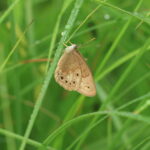
I am sure that most of us are aware that grasses and sedges or graminoids are a natural part of native plant communities. But, do we stop to consider why they may be important and even useful to restorations or our native plant gardens. I have told people for years to make wildflower or native gardens as natural as possible. This includes adding grasses and sedges to the pallet of plants. Besides the added beauty, there are many useful benefits of incorporating this group of plants to the landscape.
Graminoids have many benefits for the environment and even our quality of life. Many of our native grasses are deep rooted with two thirds of the plant’s biomass below the soil as roots. These deep, thick roots help hold loose soil in place, thus working to prevent soil erosion. Over the years of growing, dying and the decomposition of each year’s growth, these grasses improve the quality and richness of the soils. By absorbing and filtering water, they improve water quality and lessen water runoff. I have seen this at work in my own yard with heavy rain events. While my vegetable garden had standing water, the immediately adjacent prairie planting had zero standing water. When allowed to grow in thick densities as they would in natural areas, they can shade and out compete many weeds. Also, the older the planting, there should be less disturbance which is needed for many weeds to grow as many annual weeds need disturbance to germinate and thrive. Several of our native prairie grasses are also drought tolerant and thrive in dry conditions. This ability to grow in course droughty soils also means less water is needed and once established you should never need to supplement with artificial watering.
Native grasses sequester and store vast amounts of carbon rather than releasing it into the atmosphere. Larrabee and Altman noted in their book on prairies that “the simple act of plowing the grass under in such large quantities created the first appreciable increase in carbon dioxide released into the atmosphere. This historic increase seems to have begun at about the same time the prairies began disappearing around 1850.”
Grasses and sedges are also important to insects including some pollinators and predatory insects. There are 42 species of butterflies and skippers which the larvae feed on grasses in Michigan. This number does not include the many moths and other insects that also seek food, shelter and protection in the tall thick grasses. Years ago, I had thought that Satyrs and Wood Nymphs were butterflies of woodland edges as this is where I normally saw them. The truth is, that is where the grasses were along the edges of fields. When open areas are allowed to go back to grasses or are planted with native grasses, these butterflies move out into the open areas. They are laying eggs in the grasses and hiding from predators there as well. It only takes a few passes through these grassy areas with an insect net to see the high diversity of insects using and living on these plants.
If you are interested in adding native grasses to your property or garden, Little bluestem is a great species to start with. While many species of grasses and sedges are used by these insects, Little bluestem seems to be very popular with many species. Oh, don’t forget to add flowering forbes as nectar sources for the adults. By adding native grasses, sedges and flowering plants to the landscape, you may be amazed at the diversity of life you will be providing for.
 Click on the title of a post to view a full gallery of images.
Click on the title of a post to view a full gallery of images.
